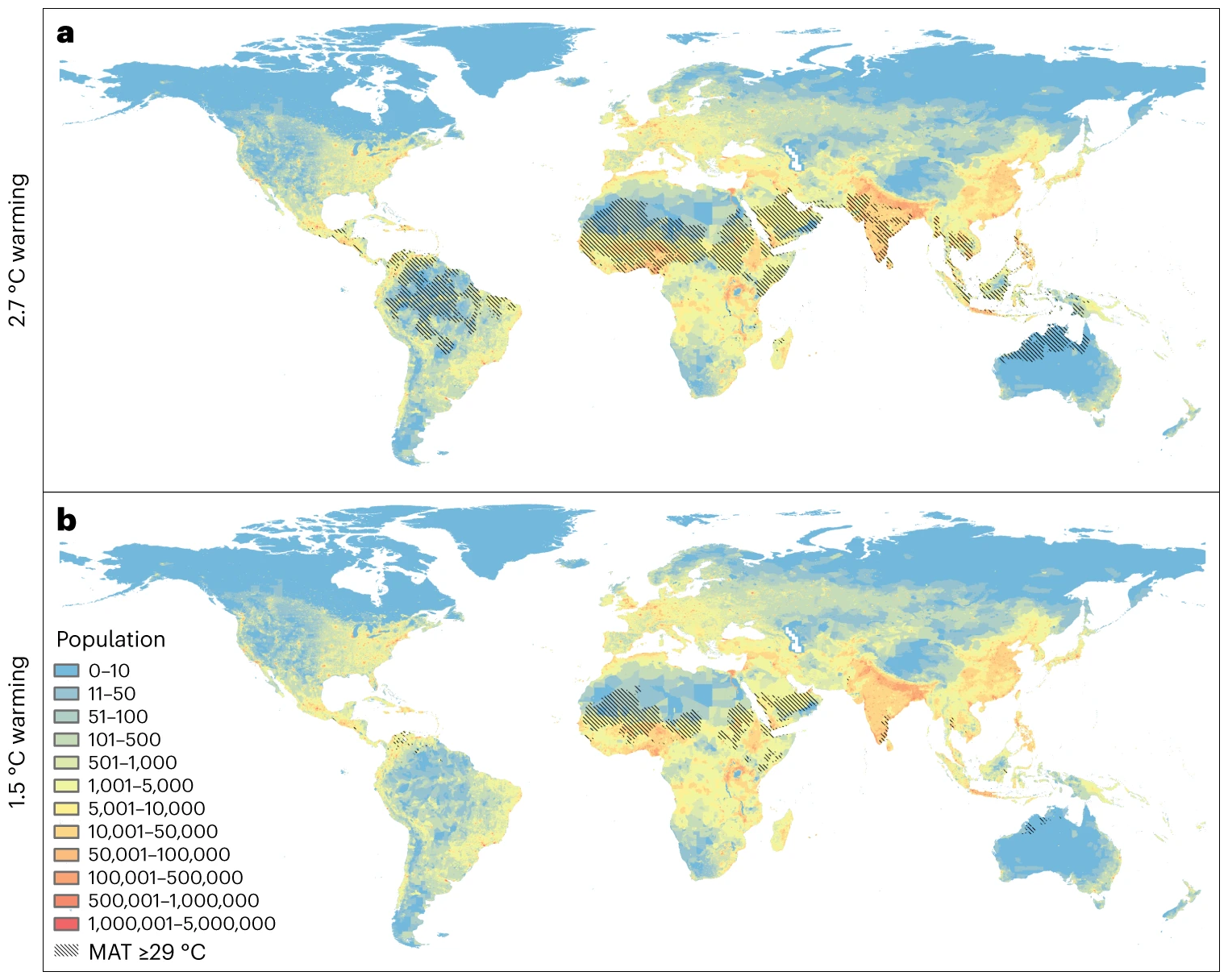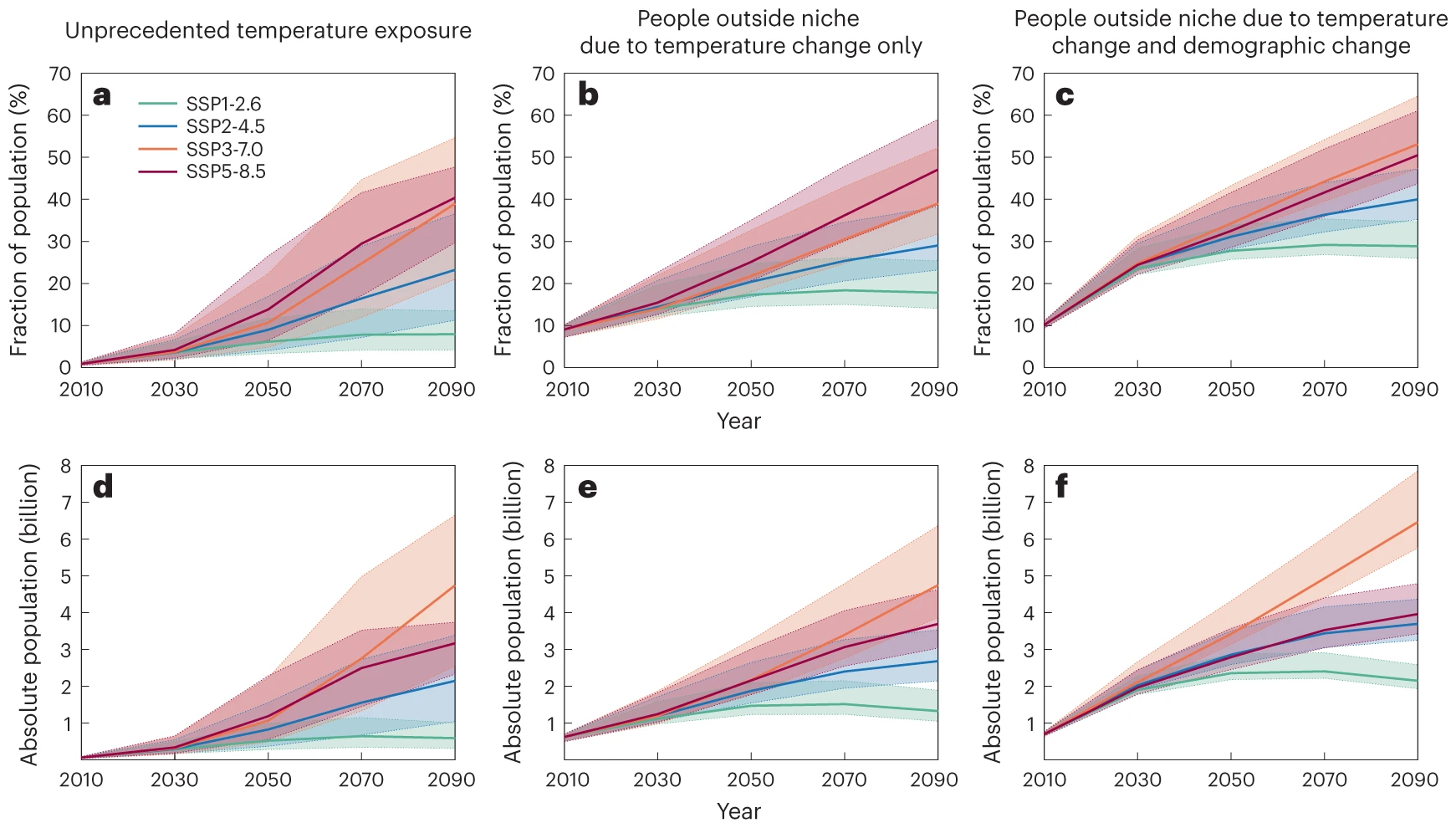Current climate policies will leave more than a fifth of humanity exposed to dangerously hot temperatures by 2100 – “For every 0.1°C of warming above present levels, about 140 million more people will be exposed to dangerous heat”

By Alex Morrison
22 May 2023
(University of Exeter) – Current climate policies will leave more than a fifth of humanity exposed to dangerously hot temperatures by 2100, new research suggests.
Despite the Paris Agreement pledge to keep global warming well below 2°C (compared to pre-industrial levels), current policies are projected to result in 2.7°C warming by the end of the century.
The new study, led by researchers at the Global Systems Institute, University of Exeter, associated with the Earth Commission, and Nanjing University, assessed what this would mean for the number of people living outside the “climate niche” in which our species has thrived.
It says about 60 million people are already exposed to dangerous heat (average temperature of 29°C or higher).
And two billion – 22% of the projected end-of-century population – would be exposed to this at 2.7°C of global warming.
The paper highlights the “huge potential” for decisive climate policy to limit the human costs and inequities of climate change.
Limiting warming to 1.5°C would leave 5% exposed – saving a sixth of humanity from dangerous heat compared to 2.7°C of warming.
The study also finds that the lifetime emissions of 3.5 average global citizens today – or just 1.2 US citizens – expose one future person to dangerous heat. This highlights the inequity of climate crisis, as these future heat-exposed people will live in places where emissions today are around half of the global average.
In “worst-case scenarios” of 3.6°C or even 4.4°C global warming, half of the world’s population could be left outside the climate niche, posing what the researchers call an “existential risk”.

“The costs of global warming are often expressed in financial terms, but our study highlights the phenomenal human cost of failing to tackle the climate emergency,” said Professor Tim Lenton, director of the Global Systems Institute at the University of Exeter.
“For every 0.1°C of warming above present levels, about 140 million more people will be exposed to dangerous heat.
“This reveals both the scale of the problem and the importance of decisive action to reduce carbon emissions.
“Limiting global warming to 1.5°C rather than 2.7°C would mean five times fewer people in 2100 being exposed to dangerous heat.”
Defining the niche
Human population density has historically peaked in places with an average temperature of about 13°C, with a secondary peak at about 27°C (monsoon climates, especially in South Asia).
Density of crops and livestock follow similar patterns, and wealth (measured by GDP) peaks at about 13°C.
Mortality increases at both higher and lower temperatures, supporting the idea of a human “niche”.
Although less than 1% of humanity currently live in places of dangerous heat exposure, the study shows climate change has already put 9% of the global population (more than 600 million people) outside the niche.
“Most of these people lived near the cooler 13°C peak of the niche and are now in the ‘middle ground’ between the two peaks. While not dangerously hot, these conditions tend to be much drier and have not historically supported dense human populations,” said Professor Chi Xu, of Nanjing University.
“Meanwhile, the vast majority of people set to be left outside the niche due to future warming will be exposed to dangerous heat.
“Such high temperatures have been linked to issues including increased mortality, decreased labour productivity, decreased cognitive performance, impaired learning, adverse pregnancy outcomes, decreased crop yield, increased conflict, and infectious disease spread.”
While some cooler places may become more habitable due to climate change, population growth is projected to be highest in places at risk of dangerous heat, especially India and Nigeria.
The study also found:
- Exposure to dangerous heat starts to increase dramatically at 1.2°C (just above current global warming) and increases by about 140 million for every 0.1°C of further warming.
- Assuming a future population of 9.5 billion people, India would have the greatest population exposed at 2.7°C global warming – more than 600 million. At 1.5°C, this figure would be far lower, at about 90 million.
- Nigeria would have the second-largest heat-exposed population at 2.7°C global warming, more than 300 million. At 1.5°C warming this would be less than 40 million.
- India and Nigeria already show “hotspots” of dangerous temperatures.
- At 2.7°C, almost 100% of some countries including Burkina Faso and Mali will be dangerously hot for humans. Brazil would have the largest land area exposed to dangerous heat, despite almost no area being exposed at 1.5 °C. Australia and India would also experience massive increases in area exposed.
The research team – which included the Potsdam Institute for Climate Impact Research, the International Institute for Applied Systems Analysis, and the Universities of Washington, North Carolina State, Aarhus, and Wageningen – stress that the worst of these impacts can be avoided by rapid action to cut greenhouse gas emissions.
Speaking about the conception of their idea, Professor Marten Scheffer, of Wageningen University, said: “We were triggered by the fact that the economic costs of carbon emissions hardly reflect the impact on human wellbeing.
“Our calculations now help bridging this gap and should stimulate asking new, unorthodox questions about justice.”
Ashish Ghadiali, of Exeter’s Global Systems Institute, said: “These new findings from the leading edge of Earth systems science underline the profoundly racialised nature of projected climate impacts and should inspire a policy sea-change in thinking around the urgency of decarbonisation efforts as well as in the value of massively up-shifting global investment into the frontlines of climate vulnerability.”
The research was funded by the Open Society Foundations and the paper is also an output of the Earth Commission – convened by Future Earth, the Earth Commission is the scientific cornerstone of the Global Commons Alliance.
Wendy Broadgate, Executive Director of the Earth Commission at Future Earth, said: “We are already seeing effects of dangerous heat levels on people in different parts of the world today. This will only accelerate unless we take immediate and decisive action to reduce greenhouse gas emissions.”
Work on climate solutions by the Global Systems Institute at the University of Exeter has identified “positive tipping points” to accelerate action, including a recent report that highlighted three “super-leverage points” that could trigger a cascade of decarbonisation.
The paper, published in the journal Nature Sustainability, is titled: “Quantifying the Human Cost of Global Warming.”
Limiting global warming to 1.5°C would save billions from dangerously hot climate

Quantifying the human cost of global warming
ABSTRACT: The costs of climate change are often estimated in monetary terms, but this raises ethical issues. Here we express them in terms of numbers of people left outside the ‘human climate niche’—defined as the historically highly conserved distribution of relative human population density with respect to mean annual temperature. We show that climate change has already put ~9% of people (>600 million) outside this niche. By end-of-century (2080–2100), current policies leading to around 2.7 °C global warming could leave one-third (22–39%) of people outside the niche. Reducing global warming from 2.7 to 1.5 °C results in a ~5-fold decrease in the population exposed to unprecedented heat (mean annual temperature ≥29 °C). The lifetime emissions of ~3.5 global average citizens today (or ~1.2 average US citizens) expose one future person to unprecedented heat by end-of-century. That person comes from a place where emissions today are around half of the global average. These results highlight the need for more decisive policy action to limit the human costs and inequities of climate change.


